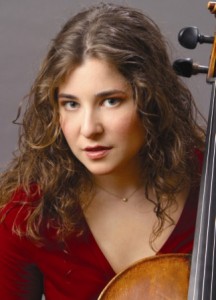Night-prowling cats, a romantic quintet, contemporary songs and a stunning cello solo will be some of the many highlights of the first Orcas Island Chamber Music Festival concert, “A Flurry of Styles,” to take place Tuesday, Aug. 18 and Wednesday, Aug. 19.
Quotes are from the OICMF program notes by Jeff O’Kelley, unless otherwise noted.
The first piece of the “Flurry” concerts, is by American composer Paul Schoenfield, born 1947. Who Let the Cat Out Last Night begins the feline-canine theme that plays throughout this season’s concerts. Written in 1980,Who Let the Cat Out Last Night is a kind of “fast and frenetic rag and draws on the styles of jazz, blues and country fiddling.
“It seems to suggest a series of nocturnal feline adventures with a distinctly urban flavor. Originally scored for electric violin, piano and percussion, its infectious rhythms are equally effective when heard, as here, in its “unplugged” version.
Festival Artistic Advisor Jon Kimura Parker will play the piano, and violinist Chee-Yun will join him on the violin in this piece.
After this lively and contemporary introduction, audiences will hear a piece by Norwegian composer, Johan Halvorsen (1864–1935), based on a theme by 18th century composer George Handel.
The piece is a “Passacaglia,” a musical form of variations, usually on a bass theme of just four to eight measures, followed by a series of adaptations, in this case, 20 variations on Handel’s original composition. Cellist Alisa Weilerstein and violinist Chee-Yun perform the piece.
“ Handel’s harmonies remain essentially unchanged but the writing for the two instruments goes well beyond the limits of 18th century string writing. There is frequent use of double-stopping (each instrument playing two notes at once) which at times creates the illusion of hearing a string quartet, and one of the variations is played sul ponticello — i.e., the bow is placed very close to the bridge of the instrument creating an eerie, nasal or metallic tone (a technique unheard of in Handel’s time). Although Halvorsen’s Passacaglia was written for violin and viola, the latter part can be readily adapted for the cello as in this performance.”

Alisa Weilerstein, Chamber Music Festival cellist, to perform with Violinist Chee-Yun, and as soloist at the "Flurry of Styles" opening concerts.
Alisa Weilerstein is sure to captivate the audience with her playing in the Halvorsen piece, but audiences can expect to be mesmerized by her solo virtuosity in Hungarian composer Zoltán Kodály ‘s Sonata for Solo Cello, Op. 8.
Kodály began collecting true Hungarian folk songs as a young man, “initially recording them with pen and manuscript paper, later (when technology permitted) turning to the gramophone… and later employed the fruits of [his research] in compositions,” much like America’s Alan Lomax.
However, the Sonata for cello doesn’t use actual Hungarian folk song motifs, but draws from those characteristics, “transformed and integrated into the composers’ own musical language.”
Kodály’s Cello Sonata “is a veritable compendium of technical challenges, the first of which is a problem, not for the hands, but for the brain. The entire sonata is played using scordatura tuning, wherein one or more strings are tuned differently from normal according to the composer’s instructions. In this case, the two lowest strings are tuned down a half-step (B and F-sharp instead of C and G). The result is that the notes that one hears do not match what one sees on the printed page.
“To put it mildly, this takes some getting used to!
“As for technique, the score positively bristles with challenges: trills and tremolos (often played simultaneously with another voice), arpeggios, rapid string crossing, left-hand pizzicato, crossed voices (where higher notes are played on a lower string at the same time that lower notes are played on a higher string), fast melismatic passages (an instrumental equivalent of coloratura writing for the voice) and quadruple-stopping (chords played on all four strings).
“The three movements may be respectively characterized as a rhapsody, lament and country-dance. The first two movements have a profound intensity of expression which in itself must be exhausting for the cellist. Wild outbursts of grief make the “slow” movement as technically challenging as its neighbors. The third movement contains imitations of bagpipes and two striking passages which are strongly suggestive of the virtuoso guitar techniques of Eddie Van Halen (b. 1955)!”
Following the intermission, the audience will vault into the 21st century as the OICMF Composer-in Residence, Gabriel Kahane (b. 1981), presents a set of songs primarily from his first album, which he considers his “pop” persona. Kahane provides this description in the OICMF Festival Program:
“Three étude-like songs are bookended … by more straightforward folk-infused tunes on either end. … Durrants … [is] a study in polyrhythm — the initial piano motif offers three beats in the left hand to five in the right, a gesture that continues over several harmonic shifts… Meanwhile, Keene is a study in bitonal harmony… a play of bitter suspensions over consonant triads roughly in the key of Bb, which then gives way to a more open B Major harmony in the choruses. In the instrumental coda, the opening vocal gesture, two repeated eighth notes, is passed around until the chorale returns to offer some respite in the final bars.
“The influence of the great Hungarian composer György Ligeti looms over Side Streets, which is almost an homage to Fanfares, the fourth étude from his first book of Piano Études.
“The Fughetta which precedes it takes its subject from the melody of the main theme. The final piece, LA, was written as a response to Joan Didion’s deeply disturbing novel, Play It As It Lays, during a three-month stay in the great city of angels.”
Joining Kahane in performance of his Songs will be:
- Rob Moose, violin/tenor and acoustic guitar
- Chee-Yun, violin
- Aloysia Friedmann, viola
- Anne Martindale Williams, cello
- Owen Kotler, clarinet/bass clarinet
- C.J. Camerieri, trumpet/piano
- Gene Nery, electric guitar
Kahane’s 2009 premiered work For the Union Dead, a chamber song cycle on poems by Robert Lowell, will be performed in the second OICMF concert series, “Happy Birthday Mendelssohn” on Aug. 21 and 22.
Kahane’s best known work, Craigslistlieder (2006) — an eight movement song cycle which comprises settings of anonymous classified ads from craigslist.org — will be feature in the final OICMF series “From Quartets to Craigslist” on Aug. 28 and 29. Kahane’s Django: Tiny Variations on a Big Dog, a solo piano work, will also be included in the program those nights.
Kahane’s appearance at the Chamber Music Festival is sponsored by Marsha and Jim Seeley.
Concluding the “Flurry” programs is Ernst von Dohnányi’s Quintet for Piano and Strings in C minor, Op. 1.
Dohnányi (1877–1960) was “one of the last extrusions of the Romantic era into the 20th century, as well as one of the last examples of the musical ‘triple-threat’ — i.e., composer, conductor and pianist.”
The Opus 1 Quintet was written when Dohnányi was only 16 years old. It “attracted considerable attention and praise, most notably from Brahms. After 1905, teaching and conducting occupied more of his time — first in Berlin, later in Budapest. … World War II brought tragedy for Dohnányi. One of his sons was killed in combat. The other, Hans, (b. 1902, father of conductor Christoph von Dohnányi) was executed for his part in a conspiracy to assassinate Hitler.
Despite these sacrifices and the fact that the composer had used his considerable influence and financial resources to protect Jewish musicians, the Communist government of Hungary which emerged after the war tried to paint Dohnányi as a Nazi collaborator which led to his departure from Hungary in 1948. After a brief period in Buenos Aires, he settled in Tallahassee,where he taught at the University of Florida for the rest of his life.
“Dohnányi’s Quintet “is clear and effective if in no way innovative, while the writing for both piano and strings is assured and idiomatic. From this point
on, his style underwent no major transformations.
“The first movement has a heroic main theme, the energy of which is enhanced rather than impeded by its hushed first statement. The second subject … has a cantabile (“in a singing style”) character.
“A striking adagio passage for all four stringed instruments playing the same notes in the same octave precedes the [final movement].
Dohnányi’s Quintet will be perfomed by OICMF musicians:
- Andrés Cárdenes, violin
- Monique Mead, violin
- Aloysia Friedmann, viola
- Anne Martindale Williams, cello
- Jon Kimura Parker, piano
Cynthia and Sam Coleman sponsor the Aug. 18 performance; the reception for this evening is sponsored by Penelope Hawkins and Hi Stickney, and sponsors of the Rosalie Chantiny pre-concert talk are Margaret and John Greever.
Wednesday night’s concert sponsors are Valerie Anders and Ann Graves. The reception is sponsored by Carol Marcin and Tom Burg and the Rosalie Chantiny post-concert talk comes courtesy of Anne and Harlan Petersen.
Tickets for all OICMF events continue to be available through waiting lists, which are re-established two to three hours prior to each concert. “Though ticket-seekers may still be disappointed, we have very productive wait lists,” says OICMF Executive Director Victoria Parker.”
**If you are reading theOrcasonian for free, thank your fellow islanders. If you would like to support theOrcasonian CLICK HERE to set your modestly-priced, voluntary subscription. Otherwise, no worries; we’re happy to share with you.**







